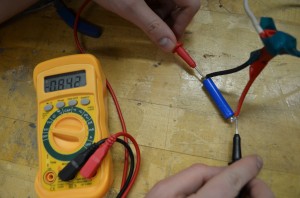
We have been busy! Construction of our plane continues, of course. Our electronic parts arrived a while ago, so testing and connecting them is one of our major tasks. Without motors, servos, and the radio receiver, our plane would just be a glider!

In more interesting news, we are considering how best to make use of our control surfaces. There is of course the rudder, which is connected to our rear landing wheel such that it acts to steer the plane whether it is taxiing or flying. There are the elevators (on the tail) which are raised or lowered together to pitch the plane up or down. And there are the wing control surfaces, known in our case as flaps or ailerons.
On larger planes there are separate flaps and ailerons. Flaps are used together to increase the wing’s coefficient of lift by tilting down, increasing the curvature of the wing. This can help a plane take off and fly safely at low speeds. Ailerons, on the other hand, tilt opposite each other to roll the plane. If the plane wants to roll to the right, it raises the right aileron and lowers the left. Thus, lift on the left wing increases and lift on the right wing decreases, causing the right wing to dip.
However, our plane is using a combined flap+aileron setup, informally known as flaperons. All this means is that our ailerons can be raised and lowered together (as flaps) or separately (as ailerons). This way we can get the benefit of flaps during takeoff and ailerons during flight, without having to add extra servomotors and control surfaces.
As always, if you are interested in building airplanes and airplane-building-related activities, stop by our weekly meetings on Mondays at 9 PM in 233 Mudd. Also head to the machine shop on the second floor of Mudd on Friday afternoons; we spend most of our build time there.
1 thought on “AIAA Weekly Update #6: Progress Report”
Comments are closed.